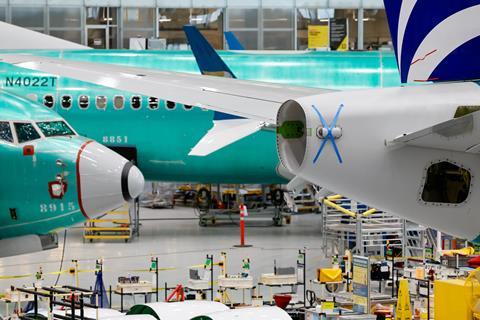Boeing has slightly raised its 20-year forecast for new aircraft, predicting airlines will need more jets than previously expected due to an extraordinarily large number of older examples that must be replaced soon.
Released on 19 July, the airframer’s 2024 Commercial Market Outlook, estimates that in the period to 2043, carriers will require 43,975 new passenger and cargo aircraft - including regional jets, narrowbodies and widebodies – an increase of 1,380 units on the total predicted a year ago.

“Capacity is constrained by the availability of new aircraft. Retirements are delayed as a result,” says Boeing vice-president of commercial marketing Darren Hulst. “Will it all be fixed in a year? I think the answer is pretty unequivocally, no.”
Hulst says market conditions have left airlines with about 2,000 fewer new aircraft than they would be flying if not for the industry’s lingering production slowdown.
By aircraft category, Boeing’s 2024 Outlook predicts carriers globally over the next 20 years will need 1,525 regional jets (down 16% from last year’s forecast), 33,380 single-aisles (up 3%), 8,065 widebodies (up 8%) and 1,005 freighters (up 9%).
Of those, roughly half are expected to replace existing aircraft and half are for fleet growth.
“The real driver of growth is still the single-aisle-type aircraft that [will] serve about 75-80% of the future delivery demand,” says Hulst.
Boeing’s demand projections translate into a global fleet that includes nearly 50,200 aircraft in 2043, or almost twice the 26,750 aircraft now in service – with an average 3.2% annual growth rate over the period.
“Market demand is still outpacing economic growth and will continue outpacing economic growth,” says Hulst. “We’ve never seen a more competitive global aviation marketplace.”
However, the aerospace industry has been struggling to meet that demand due to widespread supply chain pressure.
Airlines have recently been retiring only 1-1.5% of their jets annually, down from a historic average of 3% during the 40 years before the pandemic. As a result, today’s fleet is 10-15% older than the pre-pandemic fleet, Hulst says. “We are in a transition period as we catch up as an industry to the demand in the marketplace.”
Boeing’s forecast aligns closely with Airbus’s 20-year outlook, also released this week. The European company anticipates airlines will over 20 years require 33,510 single-aisle jets and 7,980 widebodies.


























